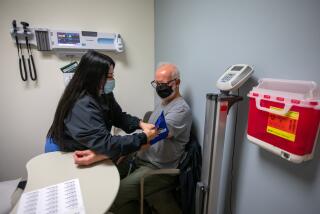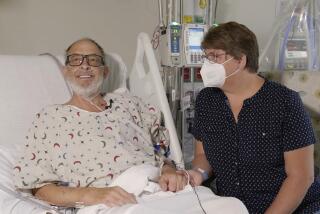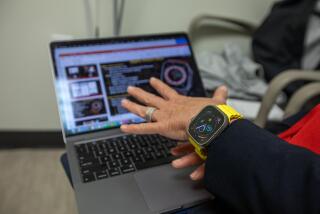An artificial heart offers a real chance
When 46-year-old Tammy Lumpkins showed up at Keck Hospital of USC in August, she needed a new heart.
Her doctors got her onto the transplant list, but as she waited, her health deteriorated. Her liver and kidneys started to fail and she couldn’t get out of bed.
“To say she was on the brink of death was an understatement,” said Dr. Michael Bowdish, a cardiothoracic surgeon at Keck Hospital.
So in late September, Bowdish implanted an artificial heart in Lumpkins to replace both of the organ’s chambers and all four valves. And on Wednesday, Lumpkins will become the first person on the West Coast to leave the hospital with such a device.
Lumpkins said she feels lucky to be alive and grateful to be leaving the hospital. Now she can watch her 19-year-old son graduate from ITT Technical Institute in December. And after nearly 20 years with heart problems, Lumpkins said Tuesday that she had renewed confidence that she would finally get better.
“I was ready to give up last summer,” she said, sitting beside her husband in front of the hospital. “Now there’s a light at the end of the tunnel and it’s getting brighter.”
Although artificial hearts aren’t new, patients have traditionally had to stay in the hospital because the machine necessary to make them work weighed more than 400 pounds. Now, new technology allows patients to go home while they wait for heart transplants. The device, which weighs almost 14 pounds, can be carried in a small backpack.
“She can go home and live a normal life,” said Bowdish, who directs the hospital’s artificial heart program.
More than 950 people have received artificial hearts and 22 people in the United States have gone home with the lightweight devices, according to Don Isaacs, spokesman for SynCardia, the Tucson-based company that manufacturers the artificial heart. The device costs about $124,000 and an additional $18,000 a year to maintain, Isaacs said. Although the heart is approved by the Food and Drug Administration, the backpack device is part of a clinical trial.
Patients can live with the artificial heart for years, although the goal is to get them transplants as soon as possible. “But the reality is there’s a wait, and sometimes a long wait,” he said.
More than 3,100 patients are waiting for heart transplants. The average wait is 168 days, according to the United Network for Organ Sharing.
“The supply doesn’t meet the demand,” said Dr. Kathy E. Magliato, a cardiothoracic surgeon and president of the American Heart Assn. board in Los Angeles. An artificial heart can save the lives of patients who cannot wait for transplants, she said.
Lumpkins, who lives near Modesto, was 28 when she was diagnosed with cardiomyopathy, a disease that weakens and enlarges the heart. Five years later, doctors told her she had congestive heart failure. Since early 2010, Lumpkins said, she has been in and out of the hospital. Her husband, Dale, an electrician, said his insurance will pay for some of the medical bills.
Because she must stay relatively close to the hospital, Lumpkins will live temporarily at a friend’s house in Hemet and return weekly for checkups. After the holidays, Bowdish said, he plans to actively start looking for a transplant heart.
With the machine pumping loudly beside her Tuesday, Lumpkins said she was nervous. “It’s scary not knowing what’s going to happen,” she said. “But I’m feeling 100% better than I ever did.”
Following the surgery to implant her artificial heart in September, Lumpkins and her husband renewed their wedding vows after 22 years of marriage. “I told her that her new heart had to love me as much as her old heart had,” he said.






